- You are here:
- Home »
- AI tools for writers
Tag Archives for " AI tools for writers "
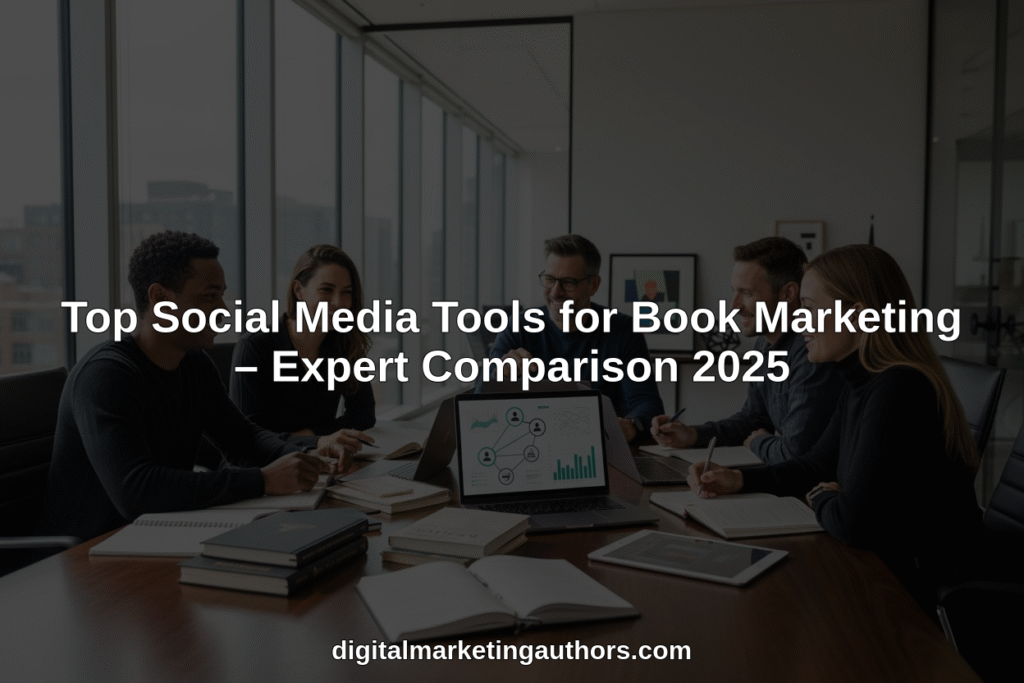
Top Social Media Tools for Book Marketing – Expert Comparison 2025
Every author wants to reach more readers and sell more books, but finding the right tools and advice can feel overwhelming. There are platforms out there promising shortcuts, easy wins, or expert coaching, yet it can be tough to know which actually delivers. Some focus on smart marketing systems, some make book design a breeze, and others offer powerful ways to build your audience and stay connected without getting lost in technical details. Imagine discovering a resource built just for writers that puts practical ideas within reach, whether you want to polish your book cover, grow your email list, or plan your next big release. The real question is which solution best matches your goals and energy. Each offers a different path to success and hidden advantages waiting to be uncovered.
Table of Contents
Digital Marketing Authors
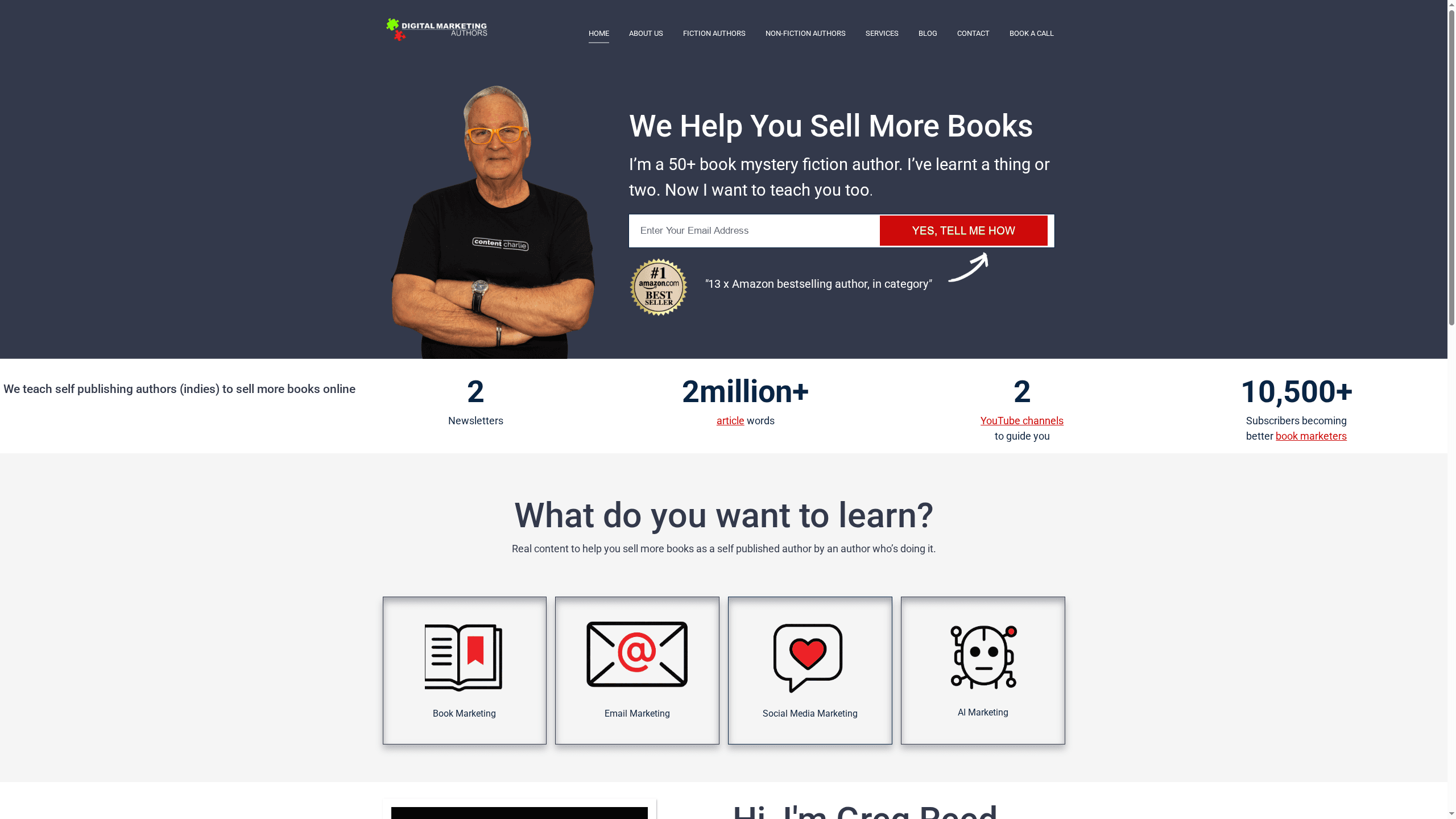
At a Glance
Digital Marketing Authors is a focused, author-first marketing resource that gives indie and self-published writers repeatable systems to sell more books. Founded by 13x #1 Amazon bestselling author C.T. Mitchell, the platform pairs author credibility with practical tactics in email, social media, and AI-driven marketing. If you want training, checklists, and step-by-step guidance aimed specifically at authors (not generic marketers), this is built for you. Expect hands-on strategies rather than vague theory.
Core Features
Digital Marketing Authors delivers targeted guides and training on email marketing, social media promotion, AI-assisted marketing, and content creation designed for book launches and ongoing audience growth. The site bundles strategic playbooks — like list-building funnels and magnetic email sequences — with resource articles such as marketing checklists and tool comparisons. Training materials emphasize automation and reader-community building, helping authors move from one-off promotions to scalable systems that consistently convert readers into repeat buyers.
Pros
- Led by a proven author-marketer: The platform is founded by 13x #1 Amazon bestselling author C.T. Mitchell, so guidance is grounded in real publishing experience and measurable results.
- Author-specific focus: Materials are tailored for self-published and indie writers, meaning examples, templates, and timelines reflect book marketing realities rather than broader corporate campaigns.
- Comprehensive, practical resources: The site includes checklists, tool comparisons, and step-by-step tutorials that let you implement tactics immediately rather than spending weeks learning theory.
- Modern marketing with AI integration: Training explicitly covers AI-powered techniques to save time and boost discoverability, keeping your marketing current and efficient.
- Proven sales and engagement methods: The platform prioritizes systems that grow email lists, automate sales funnels, and nurture a loyal reader base—methods proven to increase book sales over time.
Who It’s For
Digital Marketing Authors is ideal for self-published and indie authors who want to take control of their book marketing with systems that scale. If you write fiction or nonfiction and are committed to learning and applying practical tactics—email funnels, social media promotion, and AI-assisted content creation—this platform will accelerate your results. It’s particularly useful for authors who prefer actionable templates and checklists over academic marketing advice.
Unique Value Proposition
Digital Marketing Authors stands out because it combines frontline author credibility with explicit, execution-focused marketing systems. Unlike generic marketing platforms, it translates book marketing into repeatable playbooks: list-building tactics, automated email sequences, social media content calendars, and AI workflows tailored to book discovery. The emphasis on building a loyal reader army and automating sales moves authors away from one-hit launches and toward sustainable revenue. Backed by a bestselling author, the guidance is both strategic and granular — from subject-line formulas to promotion timing — making it superior for authors who need results without reinventing the wheel.
Real World Use Case
An independent mystery author uses the platform to grow an email list via targeted lead magnets, schedules a four-week social campaign for a new release, and deploys AI to create promotional copy and audience segments. The result: higher open rates, more preorders, and a measurable uplift in long-term reader engagement.
Pricing
Not specified on the website.
Website: https://digitalmarketingauthors.com
Kindlepreneur
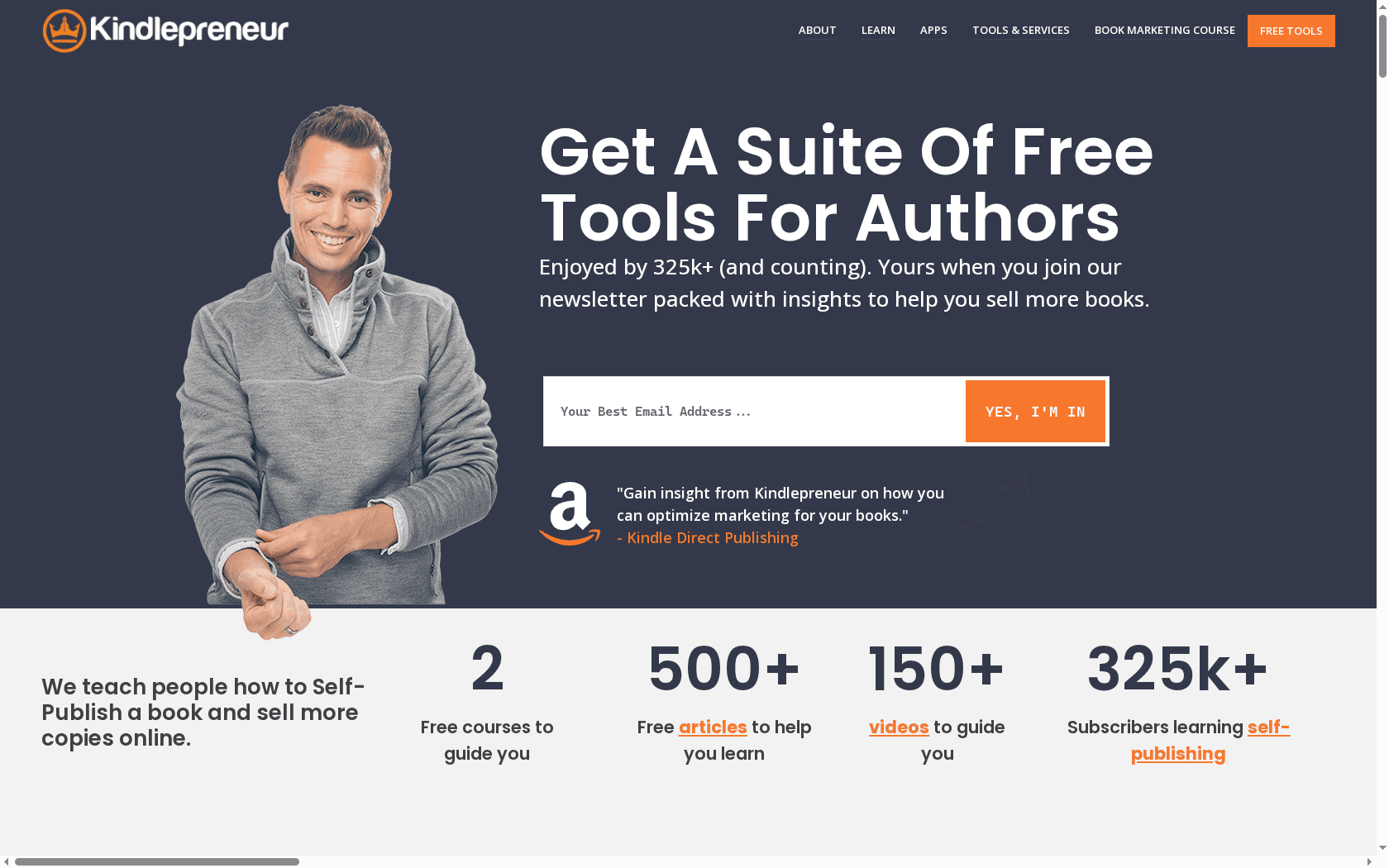
At a Glance
Kindlepreneur is a deep repository of free education and hands-on tools created for self-publishing authors who want practical, Amazon-focused book marketing help. Founded and curated by Dave Chesson, it combines more than 500 articles, 150+ videos, and a collection of free utilities that authors can use without a credit card. If you sell (or plan to sell) through Amazon KDP, Kindlepreneur delivers high-value, actionable material; outside Amazon, its relevance tapers off. Bottom line: a must-visit hub for Amazon-centric indie authors.
Core Features
Kindlepreneur’s core is educational content plus utility tools: free courses on self-publishing and book marketing, a library of over 500 written guides, 150+ instructional videos, and practical tools such as an Amazon sales rank calculator, book description generator, and QR code creator. The site also hosts resources on branding, cover design, editing, formatting, and publishing workflows—packaged to move an author from confusion to measurable action steps.
Pros
- Extensive free content: Kindlepreneur offers hundreds of articles and many videos so you can learn multiple aspects of publishing without immediate cost.
- Practical tools for Amazon sellers: Tools like the sales rank calculator and description generator give you quick, usable metrics and assets to improve listings.
- Authored by an experienced strategist: Guidance comes from a recognized self-publishing expert, which helps the advice feel grounded and credible.
- Supports all experience levels: Whether you’re writing your first indie novel or you’re a seasoned indie marketer, the site includes beginner courses and advanced tactics.
- Large engaged audience: A community of over 325,000 subscribers signals ongoing value and regular updates.
Cons
- Amazon-centric focus can limit applicability: The content and tools primarily target Kindle Direct Publishing, which reduces usefulness for authors pursuing other retailers or non-Amazon strategies.
- Some features behind paywalls: While most resources are free, certain advanced tools or courses may require payment or upgrades to access full functionality.
- Variable fit depending on skill level: The quality and usefulness of specific articles or tools can vary based on where you are in your author journey and your prior knowledge.
Who It’s For
Kindlepreneur is ideal for indie authors, self-publishers, and indie marketers who rely on—or plan to rely on—Amazon KDP as a primary sales channel. If you want step-by-step tutorials, free calculators, and tactical advice that you can apply the same day, this site was built for you.
Unique Value Proposition
Kindlepreneur stands out by pairing deep, free educational content with immediately actionable tools focused on Amazon performance. That combination lets authors both learn strategic concepts and run the tiny experiments that move visibility and sales.
Real World Use Case
An indie author uses Kindlepreneur’s Amazon sales rank calculator to estimate daily sales, applies learnings from articles to refine their Amazon Ads, and follows a free course to tighten book descriptions and metadata—resulting in clearer listings and measurable uplift in visibility.
Pricing
Free tier available; some premium tools and services may require payment.
Website: https://kindlepreneur.com
Book Brush
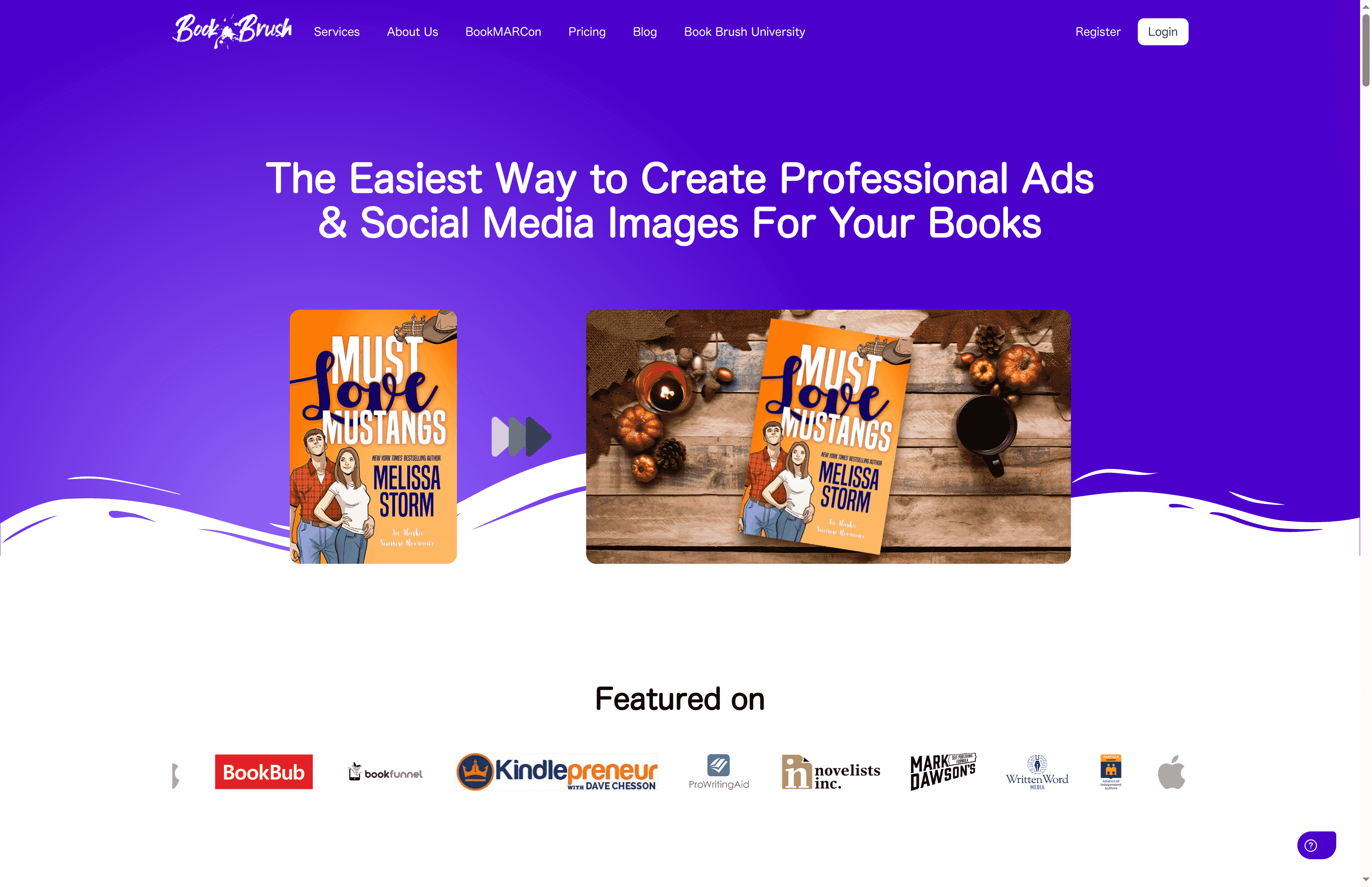
At a Glance
Book Brush is a purpose-built visual toolkit that helps authors produce professional covers, ads, mockups, and animated promos without hiring a designer. Its template library and 3D mockup options accelerate campaign-ready assets, making it a practical choice for busy indie authors and small publishers. It’s not a full-featured photo editor, though — expect convenience over pixel-perfect control.
Core Features
Book Brush bundles a large template library (over 3,000 templates) organized by platform and genre, a cover creator with hundreds of templates, and more than 200 fully customizable 3D book templates for instant mockups. The platform supports box set creation with spine options and uploads for print, ebook, audio, and other formats, and produces animated mockups and social-media-ready videos. Additional capabilities include a reader hub for sharing images, brand-consistent custom design integration, social media management services, and full-service author branding and design services.
Pros
- User-friendly interface with a wide variety of customizable templates: The platform’s organized template library lets you find genre-appropriate layouts quickly so you can build promos in minutes.
- Time-saving tools such as instant mockups and cover creators: Instant mockups and pre-built cover templates dramatically reduce the hours spent assembling campaign images.
- Affordable alternative to hiring graphic designers: For authors on a budget, Book Brush bundles many design needs into one subscription, which commonly costs less than multiple freelance jobs.
- Comprehensive suite of marketing tools tailored for authors: From covers to animated videos to box sets, the feature set maps closely to the typical tasks of book launches and ongoing promotions.
- Ability to create a consistent brand presence across multiple formats: Integration of custom designs and templated assets helps maintain cohesive branding across social posts, ads, and storefront imagery.
Cons
- Limited information on advanced editing features or unique customization options: The platform appears to favor templated workflows over deep, pixel-level editing, which may frustrate authors who want fine-grained control.
- Pricing plans may be expensive for some individual authors or small publishers: Annual plans starting at $149 may be a stretch for authors just testing paid promotion or those with very tight budgets.
- Potential learning curve for new users unfamiliar with graphic design tools: While templates simplify many tasks, authors new to visual tools may still need time to master branding consistency and animation options.
Who It’s For
Book Brush is ideal for indie authors, self-published writers, and small publishers who want fast, polished visual assets without outsourcing. If you run your own book launches and need social ads, mockups, and cover variants produced quickly, Book Brush gives you the assembly line you need.
Unique Value Proposition
Book Brush’s strength is convenience: it packages author-specific design templates, 3D mockups, animated social content, and basic brand services into a single, author-focused platform—so you can move from concept to campaign in hours instead of days.
Real World Use Case
An author preparing a release uses Book Brush to design the book cover, create promotional social graphics, generate animated teaser videos, and produce consistent box set imagery for retailer pages and ad campaigns.
Pricing
Plans range from $149/year for the Plus plan to $246/year for the Platinum plan, with higher tiers offering unlimited downloads, trailer creators, additional mockups, and webinars.
Website: https://bookbrush.com
StoryOrigin
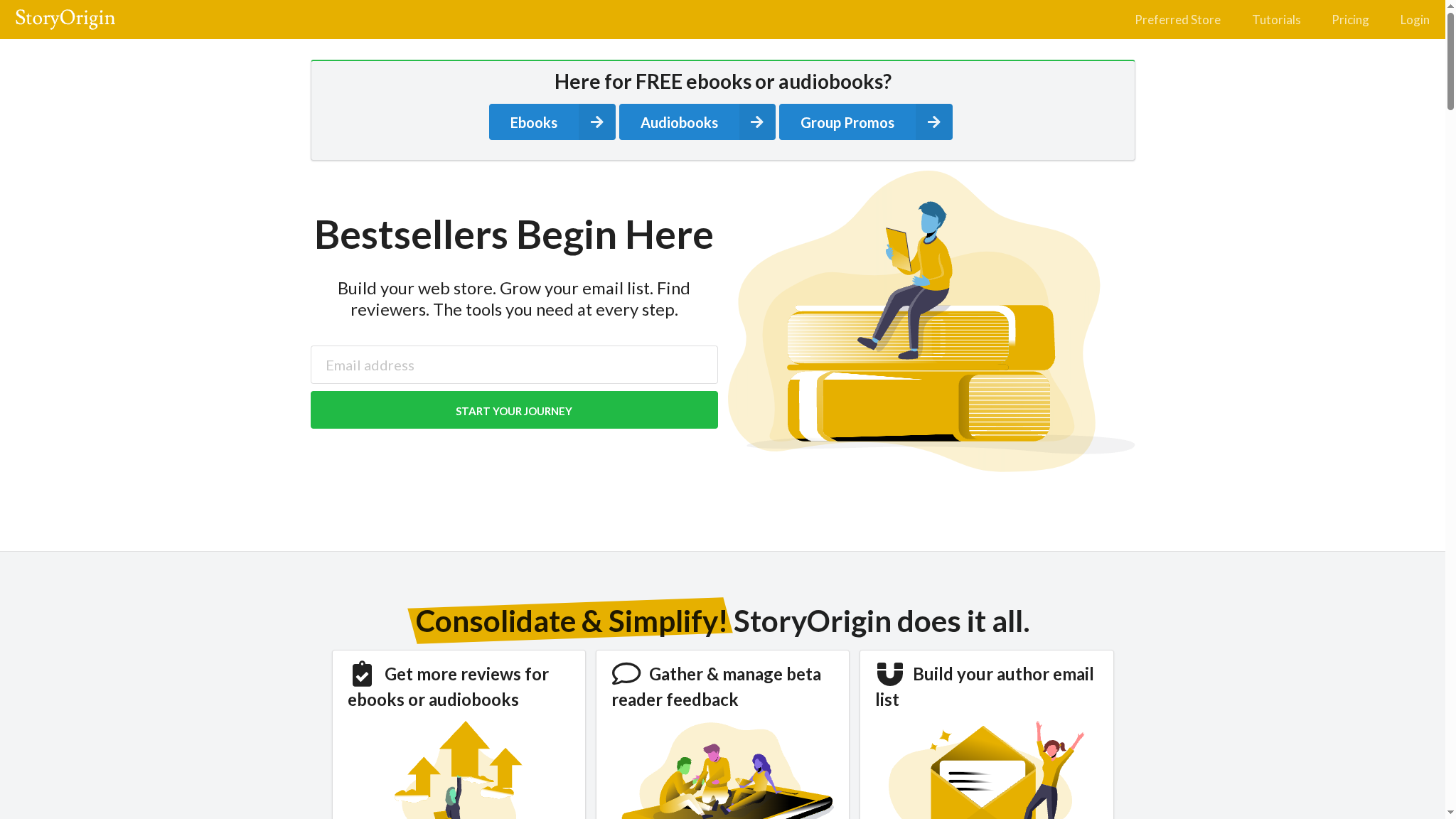
At a Glance
StoryOrigin is an all-in-one author marketing hub built to help indie and traditionally published authors grow mailing lists, manage reviews, and run collaborative promotions without juggling half a dozen separate tools. It combines list-building, reviewer outreach, newsletter swaps, and universal links into a single platform, which can save time and reduce manual follow-up. That breadth is StoryOrigin’s biggest strength — but the payoff requires a learning curve and, for many useful features, a paid plan.
Core Features
StoryOrigin’s capabilities center on streamlining author workflows: build email lists with reader magnets and landing pages; find, vet, and distribute review copies for ebooks and audiobooks; create and coordinate newsletter swaps and group promos; and generate universal links that send readers to the best store per country or preference. It also offers audiobook promo code distribution, beta reader feedback with embedded questionnaires, built-in calendars and campaign planners, writing goal tracking, and automation for reviewer follow-up and download delivery.
Not everything is surface-level. Many tasks that usually require spreadsheets or separate services—review tracking, universal links, and promo coordination—are automated inside the platform. That saves mental overhead. And yes, you can build a basic author website here, too. Small wins add up.
Stop. Think.
Pros
- All-in-one platform reduces tool sprawl: By combining list-building, review management, promotions, and universal links, StoryOrigin cuts the need to cobble together multiple services. This centralization saves time and reduces errors.
- User-friendly interface with depth: The platform is described as easy to use while still offering a long feature list, making it approachable for authors who want more than a single-purpose app.
- Strong community and positive social proof: The product benefits from a supportive author community, which can accelerate learning and provide promo partners.
- Flexible promotional options: Newsletter swaps, group promos, and automated reviewer workflows give authors multiple ways to reach readers and coordinate with other authors.
- Comprehensive review and feedback tracking: From ARC distribution to embedded beta-reader questionnaires, StoryOrigin helps you collect and manage feedback systematically.
Cons
- Complex for new users: Because StoryOrigin bundles many features, initial navigation can feel overwhelming, especially for authors who prefer minimal tools.
- Key features behind paid tiers: Several of the most useful capabilities—group promos, newsletter swaps, and advanced review management—require the Standard plan, limiting the free tier’s practicality.
- Limited free features: The free basic plan exists, but most authors aiming for real list growth and promo coordination will need to upgrade to access value-driving tools.
Who It’s For
StoryOrigin suits authors and indie writers who are serious about growing an audience and managing promotions efficiently. If you run newsletter swaps, share ARCs, or coordinate multi-author promos, StoryOrigin streamlines those tasks and reduces back-and-forth. It’s less ideal for authors who want a single, ultra-simple tool without any setup.
Unique Value Proposition
StoryOrigin’s unique value lies in packing multiple author-specific marketing tools into one platform tailored to the book ecosystem: reviewer discovery, ARC distribution, universal links for global sales, and campaign planning live together so you can coordinate launches and promos without spreadsheets.
Real World Use Case
An indie author uses StoryOrigin to organize newsletter swaps, distribute ARC copies to vetted reviewers, and create universal links for a recent release. The result: smoother ARC delivery, clearer review tracking, and a stronger mailing list ready for launch announcements.
Pricing
Starting at Free; Standard plan $10/month or $100/year, with an optional guided setup that involves a setup fee.
Website: https://storyoriginapp.com
Publer
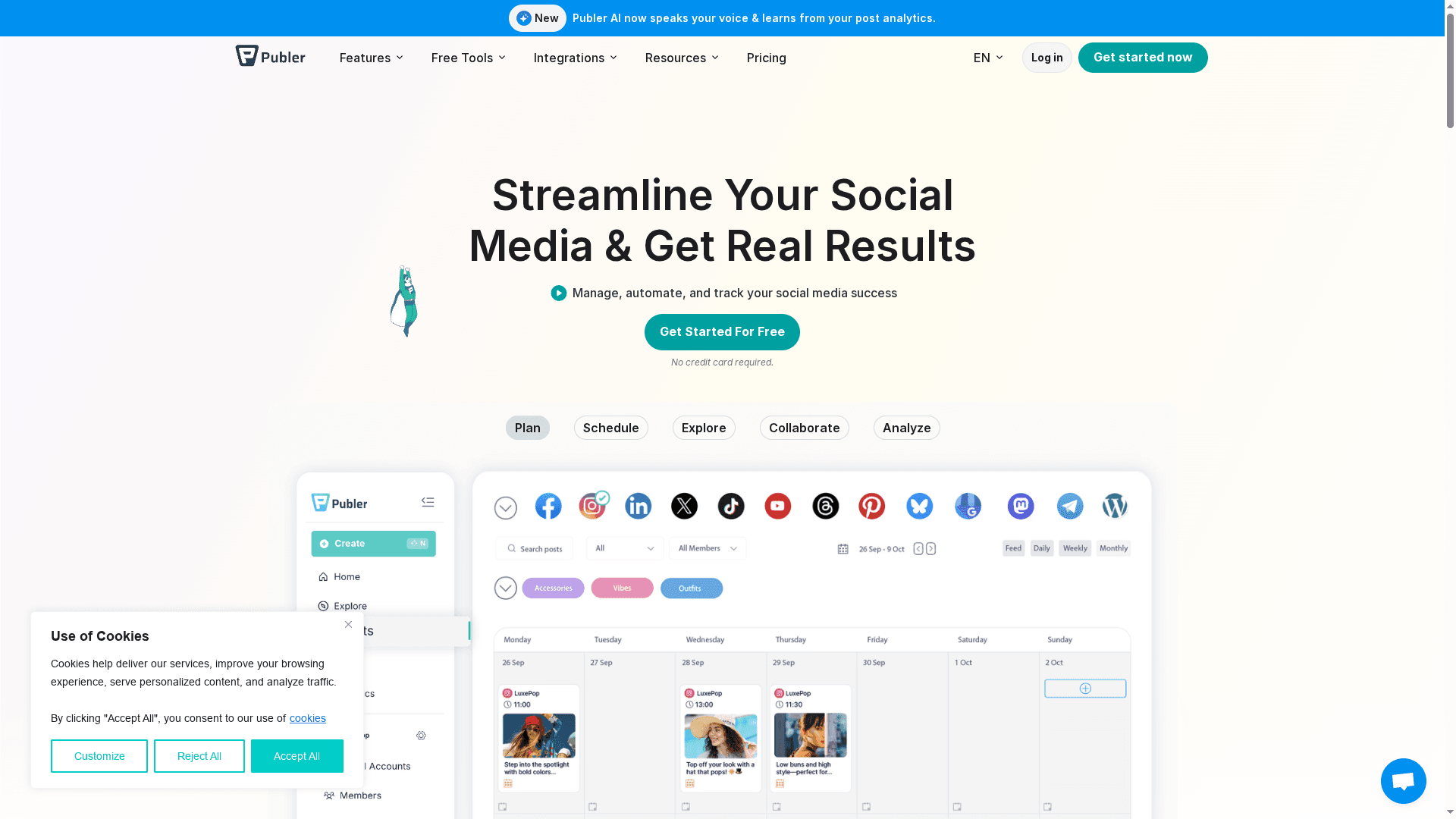
At a Glance
Publer is a full-featured social media management platform built to simplify scheduling, automation, and analytics across multiple networks. For authors and book marketers, it offers practical tools—bulk scheduling, content recycling, and AI-assisted writing—that reduce repetitive work and keep your feed consistent. It’s approachable for solo authors but scalable enough for agencies and marketing teams. Expect a short learning curve for advanced automation, and consider paid plans for larger teams or heavy feature use.
Core Features
Publer centers on cross-platform social media scheduling and automation, with built-in content creation and editing tools so you can craft posts without leaving the app. It supports analytics and insights to track performance, collaboration and approval workflows for teams and clients, and bulk uploading via CSV or a multi-post scheduler for rapid campaign setup. Additional capabilities include AI content generation, link-in-bio management, content recycling, and integrations with popular design and storage tools.
Pros
- User-friendly interface with a drag-and-drop calendar makes planning weeks of posts quick and visual. This lowers the friction for authors who prefer visual scheduling over spreadsheets.
- Comprehensive automation tools including auto-schedule and recycling reduce manual reposting and keep evergreen content working for you. Save time and maintain presence without constant oversight.
- Deep analytics provide the data you need for better decision-making about what content actually drives engagement. That’s crucial when every promotional post should move the needle on visibility or sales.
- Integration with tools like Canva and Google Drive streamlines content creation and asset management. You can pull visuals and drafts into Publer without broken workflows.
- Flexible plans cater to individuals, businesses, and enterprises so you can scale as your audience grows. Start small and upgrade when you need team features.
Cons
- Some features are limited in free plans, which can frustrate users who want to trial advanced automation and analytics. You may hit restrictions before you’ve tested the tool fully.
- Pricing can be high for larger teams or advanced features, making it a significant monthly commitment for agencies managing many client accounts. Budget accordingly.
- There is a learning curve for extensive automation options, so expect to invest time to set up complex recycling or approval workflows correctly. Don’t assume everything will work optimally out of the box.
Who It’s For
Publer is ideal for social media managers, small business owners, content creators, agencies, and enterprise marketing teams who need an integrated platform to schedule, automate, and analyze social content. If you manage multiple author profiles or client accounts and value bulk operations and collaboration, Publer fits well.
Unique Value Proposition
Publer’s value lies in combining practical automation—bulk scheduling, recycling, and AI content assistance—with collaboration and analytics in one interface. For authors, that means less time juggling posts and more time writing, while teams gain clearer approval workflows and measurable performance data.
Real World Use Case
A digital marketing agency uses Publer to schedule and analyze posts across several clients’ accounts, automate content recycling for evergreen promotions, and share drafts with clients for approval—streamlining campaign workflows and reducing manual coordination.
Pricing
Free tier available; paid plans include Professional, Business, and Enterprise with varying features and custom options.
Website: https://publer.io
Author Marketing Tools Comparison
Here’s a comprehensive comparison of popular author marketing tools, showcasing their unique features, pros, cons, and pricing to help authors make informed decisions.
| Tool | Key Features | Pros | Cons | Pricing |
|---|---|---|---|---|
| Digital Marketing Authors | Email, Social Media, AI Marketing Templates & Checklists for Authors |
Proven Author Insights Comprehensive Resources Modern with AI Integration |
Pricing not specified | Not specified |
| Kindlepreneur | Amazon-focused Tools & Courses 500+ Articles, 150+ Videos |
Extensive Free Content Amazon Tools for Sellers Large Audience |
Amazon-centric Focus Some Paywalls |
Free, Some Paid Features |
| Book Brush | 3,000+ Templates Cover Creator, 3D Mockups, Animation |
User-Friendly Time-Saving Tools Affordable Design Solutions |
Limited Advanced Editing Learning Curve Pricing High for Some |
$149-$246/year |
| StoryOrigin | Email & Review Management Newsletter Swaps, Universal Links |
All-in-One Platform User-Friendly Strong Community |
Complex for New Users Most Features Paid |
$0-$10/month |
| Publer | Social Media Management Automation, Bulk Scheduling |
User-Friendly Interface Comprehensive Automation Deep Analytics |
Limited Free Features High Pricing for Advanced Features |
Free, Paid Plans Available |
Master Social Media Marketing for Your Books with Proven Systems
Social media marketing can feel overwhelming when you face scattered tools and unclear strategies. This article highlights the challenge of finding the right platforms and automation to save time while boosting book visibility and sales. If you are struggling to manage posts, engage readers consistently, and turn casual followers into loyal fans, you are not alone. Key goals include simplifying scheduling, maximizing engagement, and leveraging AI-powered content creation to work smarter not harder.
At Digital Marketing Authors, we understand these struggles deeply. Founded by 13x #1 Amazon bestselling author C.T. Mitchell, our platform focuses exactly on helping authors build scalable, repeatable marketing systems—from magnetic email sequences to AI-enhanced social media workflows. We give you templates, checklists, and step-by-step playbooks tailored for authors who want to stop guessing and start selling more books.
Tap into expert strategies that transform your social media chaos into a streamlined engine for growth.
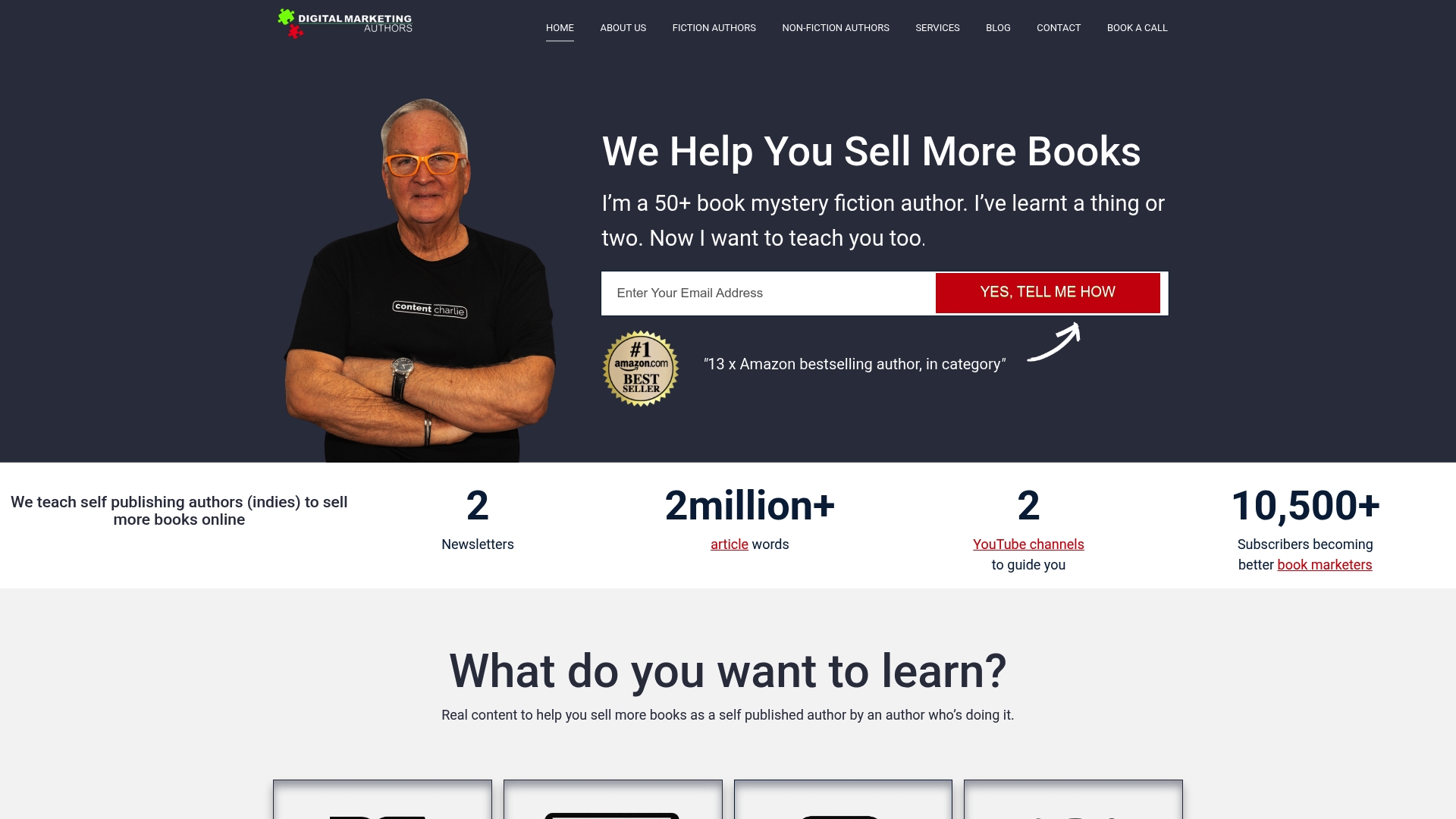
Ready to stop spinning your wheels and grow a loyal reader community with less stress? Explore our proven author marketing frameworks and AI tools now at Digital Marketing Authors. Start marketing smarter today and watch your book sales accelerate with actionable guidance designed for indie authors just like you.
Frequently Asked Questions
What are the essential social media tools for book marketing in 2025?
To effectively market books in 2025, essential social media tools include scheduling platforms for posts, analytics software for performance tracking, and audience engagement tools. Begin by assessing your needs for automation and analytics to select tools that promote consistent engagement with readers.
How do I automate my social media posts for book marketing?
To automate social media posts, utilize a scheduling tool that allows you to queue up multiple posts in advance. Set aside time weekly to create content and schedule posts, ensuring you maintain a steady online presence without daily management.
What metrics should I track to measure my book marketing success on social media?
Key metrics to track include engagement rates, follower growth, and post reach. Focus on monthly reports to analyze trends; for example, aim for a 10% increase in engagement over the next quarter by refining your content strategy.
How can I grow my audience using social media tools?
Use audience engagement tools to create interactive content, such as polls or giveaways, that encourages followers to participate and share. Aim for a campaign that targets a 15% increase in followers within 30 days by offering engaging visuals and dynamic posts.
What types of content should I share on social media to promote my books?
Share a mix of engaging content like behind-the-scenes insights, reader testimonials, and excerpts from your book. Plan a content calendar with at least one promotional post per week to keep your audience engaged and informed.
Can I collaborate with other authors using social media tools?
Yes, many social media tools facilitate collaboration by allowing content sharing and coordinated campaigns. Establish partnerships and plan joint promotions to expand your reach, aiming to increase collective followership by up to 25% within a couple of months.
Recommended

AI Strategies for Book Marketing: Boost Sales with Proven Steps
Over 80 percent of authors who use AI in their marketing see a significant rise in reader engagement. Connecting your book with its perfect audience can feel overwhelming, yet targeted strategies and smart tools make the difference between missed opportunities and true fan connection. Discover how authors are using data and AI techniques to craft authentic marketing that increases discoverability, builds loyalty, and drives sales.
Quick Summary
| Key Point | Explanation |
|---|---|
| 1. Understand Your Author Brand | Analyze your author brand and audience data to create targeted marketing strategies. |
| 2. Leverage AI for Targeting | Use AI tools to segment your audience and provide personalized marketing messages. |
| 3. Create Automated Email Sequences | Develop automated, engaging email sequences tailored to reader interactions for better conversions. |
| 4. Optimize Book Listings with AI | Utilize AI writing tools to enhance your book descriptions for improved visibility in searches. |
| 5. Monitor and Adjust Your Campaigns | Regularly track performance metrics and refine your strategies based on reader engagement and feedback. |
Table of Contents
- Step 1: Assess Your Author Brand And Audience Data
- Step 2: Integrate AI Tools For Reader Targeting
- Step 3: Automate Email Sequences Using AI Insights
- Step 4: Optimize Book Listings With AI-Powered Content
- Step 5: Monitor Results And Refine AI Marketing Campaigns
Step 1: Assess Your Author Brand and Audience Data
Successful book marketing begins with understanding your unique author brand and knowing exactly who your readers are. This step helps you create targeted strategies that connect authentically with your audience.
Start by conducting a comprehensive audience analysis using AI-powered tools. According to a 2024 research study from the author visibility online archives, personalization at scale allows authors to tailor their narrative precisely to audience context and preferences.
Gather data through multiple channels. Examine your existing reader demographics from social media insights, email subscriber information, and book review platforms. Look for patterns in age groups, reading preferences, geographic locations, and engagement levels. The SOMONITOR framework suggests using explainable AI to analyze audience personas and refine your brand strategy based on actual campaign data.
Create a detailed reader persona that goes beyond basic demographics. What are their reading habits? What emotional needs do your books fulfill? What challenges might prevent them from discovering your work?
Pro Tip: AI analysis tools can help uncover nuanced insights about your audience that traditional market research might miss.
Once you have a clear picture of your audience, you can start crafting marketing messages that resonate deeply and authentically. Your next step will be developing a targeted marketing approach based on these insights.
Step 2: Integrate AI Tools for Reader Targeting
Now that you understand your audience, its time to leverage AI tools to precisely target and engage your potential readers. This step will help you transform audience insights into strategic marketing actions.
Start by exploring AI powered tools designed for reader targeting. According to a 2024 academic study on marketing personalization, AI can leverage consumer behavior patterns to deliver highly targeted recommendations. AI tools for writers can help you analyze reader preferences with unprecedented accuracy.
Implement AI driven segmentation strategies. Adobe research indicates that brands can now tailor messages based on user activity and profile characteristics. For authors, this means creating laser focused marketing campaigns that speak directly to specific reader segments. Consider using AI platforms that can track reader interactions across multiple channels like social media, book review sites, and email platforms.

Utilize predictive analytics to understand reader interests. AI algorithms can help you anticipate reading preferences by analyzing patterns in genre selection, reading speed, and engagement metrics. This allows you to craft marketing messages that resonate on a deeply personal level.
Pro Tip: Always balance AI insights with your authentic author voice to maintain genuine reader connections.
By integrating these AI targeting strategies, you transform generic marketing into a precision instrument for reader engagement. Your next step involves developing personalized content that speaks directly to these identified reader segments.
Step 3: Automate Email Sequences Using AI Insights
Transform your reader communication by creating smart, automated email sequences that engage and convert potential readers. This step will help you build a powerful marketing system that works continuously without constant manual intervention.
Begin by mapping out a strategic email sequence using insights from artificial intelligence marketing for authors. According to FriesenPress, a successful email automation flow typically includes multiple stages: a welcome email with a free chapter, a delayed follow-up prompting purchase, and subsequent messages that encourage series continuation.
Leverage AI tools to personalize each email touchpoint based on reader interactions. This means crafting emails that dynamically adjust content depending on how readers have previously engaged with your books or marketing materials. An author marketing resource suggests creating automated post-purchase sequences that include follow-ups and review prompts triggered by specific purchase events.
Design your email sequence to feel conversational and authentic. Use AI to help analyze language patterns that resonate with your specific reader segments. This allows you to create messages that sound personal and engaging rather than generic and automated.
Pro Tip: Always include an easy unsubscribe option and respect reader preferences to maintain trust.
By implementing these AI-powered email automation strategies, you create a sophisticated marketing system that nurtures reader relationships effortlessly.
Your next step involves tracking and refining these email sequences based on reader engagement metrics.
Step 4: Optimize Book Listings with AI-Powered Content
Make your book stand out in a crowded marketplace by leveraging AI technologies to create compelling and searchable book listings. This step will transform your book description from generic text to a strategic marketing tool that attracts and converts potential readers.
Utilize AI writing tools to craft metadata and descriptions that maximize discoverability. AI-powered book promotion strategies can help you analyze keyword trends and optimize your book listing for search algorithms used by platforms like Amazon.
Generate multiple description variations using AI to test which resonates most with your target audience. AI can help you analyze language patterns that trigger reader interest by examining successful book descriptions in your genre. This means creating metadata that not only describes your book but also speaks directly to your ideal reader.
Implement AI-driven keyword optimization to improve your book visibility. Focus on long-tail keywords that precisely match potential reader search intentions. Consider using AI tools that can suggest semantically related terms that expand your book’s discoverability without feeling forced or unnatural.
Pro Tip: Always review and personalize AI generated content to maintain your unique author voice.
By strategically applying these AI optimization techniques, you create book listings that are both algorithmically intelligent and authentically compelling. Your next step involves tracking listing performance and continuously refining your approach.
Step 5: Monitor Results and Refine AI Marketing Campaigns
Transform your book marketing approach from guesswork to precision by implementing systematic tracking and continuous optimization of your AI powered campaigns. This step will help you understand what truly drives reader engagement and sales.
Leverage advanced campaign tracking tools to monitor your marketing performance in real time. According to the SOMONITOR explainable AI framework, continuous analytics enable authors to interpret campaign data and refine messaging strategies dynamically.
Set up comprehensive tracking dashboards that capture key performance indicators such as email open rates, click through rates, book listing conversions, and reader engagement metrics. AI platforms like AI Amazon Listings offer performance tracking features that can automatically recommend optimization strategies based on your current campaign data.
Implement a systematic approach to campaign refinement. This means regularly analyzing your metrics not just for surface level numbers but for deeper insights into reader behavior. Look for patterns in how different audience segments respond to your marketing messages and adjust your strategies accordingly.
Pro Tip: Treat your marketing campaigns like scientific experiments continuous testing and incremental improvements will yield the best results.
By adopting this data driven approach to marketing, you transform your book promotion from a static process to a dynamic intelligent system. Your next step involves integrating these insights into an evolving marketing strategy that grows more effective with each campaign.
Here’s a comparison of key AI strategies for each step of author book marketing:
| Step | Main AI Strategy | Primary Benefits |
|---|---|---|
| Assess Brand & Audience | Audience analysis tools | Deep reader insights Persona refinement |
| Reader Targeting | Segmentation & predictive analytics | Targeted messaging Higher engagement |
| Automate Emails | AI-driven sequences | Personalized emails Improved conversions |
| Optimize Listings | AI content & keyword tools | Better visibility Higher discoverability |
| Monitor & Refine | Campaign tracking & analytics | Real-time adjustments Continuous improvement |
Ready to Turn Data Into Book Sales?
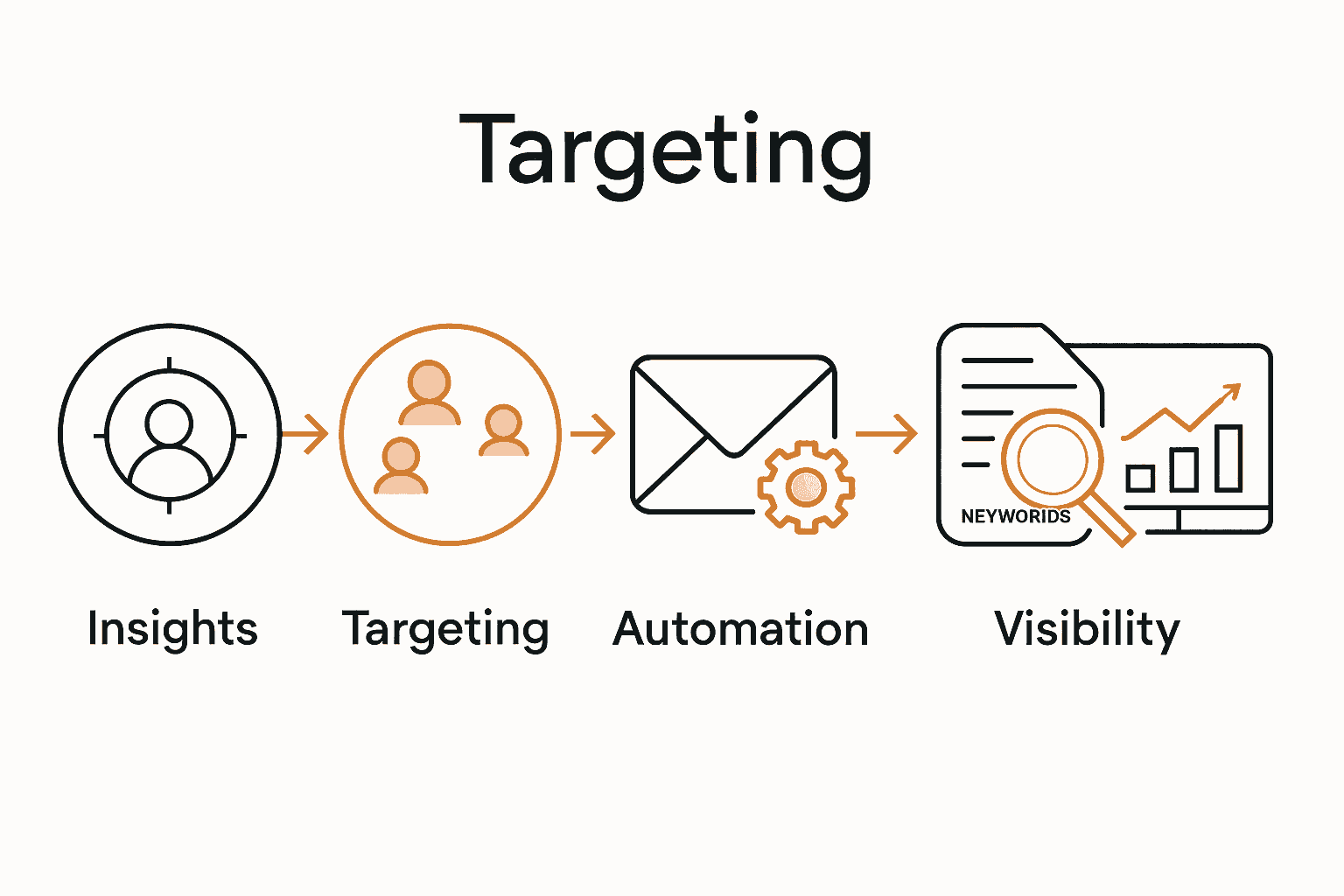
Tired of wondering if your book promo is reaching the right readers? The article above reveals a problem many authors face: generic marketing and missed connections leave promising books languishing in obscurity. Discover how AI-driven audience analysis, tailored messaging, and automated campaigns can finally break the cycle so your work finds the loyal fans it deserves. If you crave a system that transforms insights into real reader engagement, you are in the right place.

At Digital Marketing Authors you can access proven frameworks for AI-powered book marketing. Founded by an Amazon bestselling author, our platform teaches you to personalize every campaign, automate your email outreach, and amplify your author brand. Master the same strategies featured in our AI tools for writers resources to boost your visibility and finally scale your readership.
Visit Digital Marketing Authors today and unlock smart systems built for indie authors ready to grow now. Take action and watch your book sales thrive with targeted AI solutions.
Frequently Asked Questions
How can I analyze my audience effectively for book marketing?
To analyze your audience effectively, use AI-powered tools to collect data from various channels such as social media and email subscribers. Track demographics, reading preferences, and engagement levels to create a detailed reader persona that informs your marketing strategies.
What are the benefits of using AI tools for reader targeting?
Using AI tools for reader targeting allows you to deliver personalized marketing messages based on consumer behavior patterns. Implement AI-driven segmentation to craft campaigns that speak directly to specific reader segments, potentially increasing engagement by over 30%.
How can I automate my email marketing sequences?
You can automate your email marketing sequences by mapping out a strategic flow that includes welcome messages, follow-ups, and post-purchase communications. Use AI to personalize content for each email based on reader interactions, which can significantly improve conversion rates within the first few weeks after implementation.
What should I include in my book listing descriptions to optimize visibility?
To optimize your book listing descriptions, focus on crafting compelling metadata using AI tools. Incorporate relevant long-tail keywords that match potential reader search intentions, which can enhance discoverability and increase your book’s visibility in search results.
How can I monitor and refine my AI marketing campaigns?
You can monitor and refine your AI marketing campaigns by setting up tracking dashboards that assess key performance indicators such as email open rates and engagement metrics. Analyze these metrics regularly to make data-driven adjustments, enhancing campaign effectiveness by around 20% over time.
What steps should I take for ongoing optimization of my marketing strategies?
For ongoing optimization, implement a systematic approach to regularly analyze campaign data for insights on audience response. Treat your marketing campaigns as continuous experiments, allowing you to test and adjust strategies for gradual improvement.
Recommended
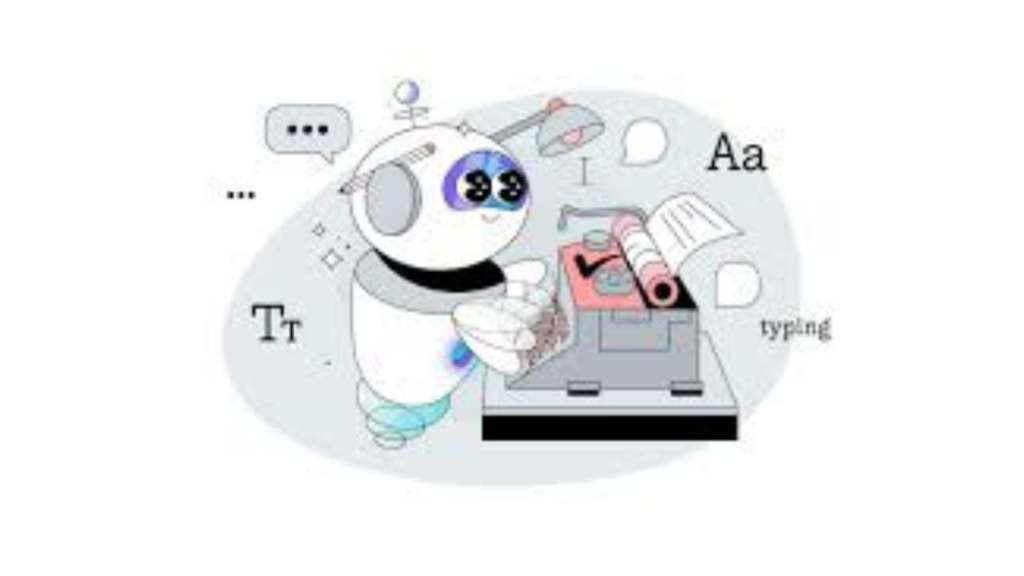
Writing with AI for Beginners: A Step-by-Step Guide
Writing with AI isn’t as simple as pressing a button and watching a book magically appear. Many beginners give up quickly when their first attempts produce low-quality, generic, or unusable content. However, by using the right tools, models, and techniques, AI can transform your writing process and even enhance creativity.
In this guide, we’ll cover:
✔️ The best AI writing tools
✔️ How to get better output from AI
✔️ Key techniques to improve AI-generated content
Whether you’re a fiction author, blogger, or non-fiction writer, this guide will help you unlock AI’s full potential in your writing.
Understanding AI Writing: Large Language Models vs. Writing Tools
AI writing is powered by Large Language Models (LLMs)—advanced AI systems trained on vast amounts of data. However, AI tools act as the interface that makes using these models easier.
What Are Large Language Models (LLMs)?
LLMs are the brains behind AI writing. The most popular ones include:
- GPT-4 (OpenAI) – Used in ChatGPT and many AI writing tools.
- Claude (Anthropic) – Known for its creative and structured writing.
- Gemini (Google) – A powerful AI with advanced reasoning.
- Llama (Meta) – Open-source AI for customized models.
- Mistral – Popular for specific writing tasks and content generation.
AI Writing Tools That Use LLMs
AI tools wrap LLMs into user-friendly platforms, providing additional features such as content structuring, brainstorming, and formatting.
Some of the most effective AI writing tools for beginners include:
✔️ ChatGPT (OpenAI) – A flexible AI chatbot for writing, brainstorming, and editing.
✔️ Claude (Anthropic) – Great for fiction and structured content.
✔️ Sudowrite – Tailored for novelists, with AI-assisted storytelling features.
✔️ NovelCrafter – Built specifically for long-form fiction writing.
✔️ RiteBot AI – A tool for generating articles, book outlines, and AI-assisted brainstorming.
How to Use AI Effectively for Writing
Many beginners struggle with AI because they expect perfect content from the start. The key is to guide the AI properly using the following strategies.
1. The F.I.T.S Framework for Better AI Output
To get high-quality writing, follow the F.I.T.S. method when prompting AI:
🔹 F – Framework
Give the AI a clear structure to follow. Instead of saying “Write a novel outline,” say:
📝 “Create a novel outline using the Hero’s Journey structure.”
🔹 I – Identity
Assign the AI a role to improve accuracy. For example:
📝 “You are a bestselling mystery author. Write a gripping first chapter.”
🔹 T – Task
Be specific about what you want the AI to do. Instead of “Write about space travel,” say:
📝 “Write a detailed introduction about the effects of space travel on human psychology.”
🔹 S – Style
Give style instructions to match your voice. Instead of “Write a story,” say:
📝 “Write a suspenseful crime scene in the style of Agatha Christie.”
2. The Fractal Technique: Writing in Steps
Instead of generating full articles or books in one go, break the writing process into smaller steps:
1️⃣ Brainstorm Ideas – Ask AI to suggest unique book or article ideas.
2️⃣ Outline the Structure – Generate a chapter-by-chapter breakdown.
3️⃣ Expand Key Points – Flesh out sections one by one.
4️⃣ Draft the Content – Let AI generate a first draft based on your outline.
5️⃣ Edit & Validate – Manually refine the AI’s output for accuracy and style.
By working step-by-step, you keep the writing process structured and manageable.
3. Chain-of-Thought Prompting: AI That Thinks Before Writing
Instead of asking AI to “Write an article,” guide it through a thinking process first:
✔️ Step 1: Ask AI to plan the content
📝 “Create a detailed outline for an article about AI writing for beginners.”
✔️ Step 2: Review & refine the outline
📝 “Now expand on Point 1 with examples and clear explanations.”
✔️ Step 3: Let AI write based on the outline
📝 “Using the outline, generate a detailed article in a conversational tone.”
This technique helps AI produce higher-quality and more structured content.
Best AI Settings for Writing: Tweaking the Output
When using AI directly through an API (such as OpenAI’s Playground or OpenRouter), you can control specific parameters for better results:
✔️ Temperature:
- Lower (0.7 or below) → More factual & predictable writing.
- Higher (1.2 or above) → More creative & unpredictable writing.
✔️ Max Tokens:
- Affects how much AI can generate in one response.
- Increase if AI cuts off mid-sentence.
✔️ Top P & Frequency Penalty:
- Adjusts variety & repetition in AI’s word choices.
For long-form writing, keeping temperature at 1.0-1.2 gives a balance of creativity and coherence.
AI for Editing & Refining Content
Even the best AI-generated drafts need editing. Here’s how AI can also help polish writing:
✔️ Grammar & Clarity:
Tools like ProWritingAid or Grammarly refine AI-generated text.
✔️ Style Adjustments:
Ask AI to rewrite content in a different tone or complexity level.
📝 “Make this paragraph more engaging and conversational.”
✔️ Fact-Checking & Validation:
AI can assist with research, but always verify sources manually.
Conclusion: AI Writing is a Tool, Not a Replacement
AI won’t replace human creativity, but it can enhance productivity and idea generation. The key to success is understanding how to guide AI properly.
✅ Use the right AI tools for your needs.
✅ Apply structured prompts like the F.I.T.S. method.
✅ Break writing into steps using the Fractal Technique.
✅ Refine AI-generated content with editing tools and manual input.
By combining AI efficiency with human creativity, you can write faster, smarter, and better!
